Abstract
Contact allergens sensitize the immune system by the binding to and subsequent activation of Langerhans cells (LCs), the antigen-presenting cells of the skin. At present, new chemicals are usually tested for their contact allergenicity in animal models. To develop an animal-replacing predictive in vivo assay for the identification of potential contact allergens, we compared the effects of epicutaneous application of six known contact allergens, five known irritants and two dermatologically inactive chemicals on LCs in skin biopsy cultures from seven healthy donors. Immunohistochemical analysis of cryostat sections of all the biopsies treated with contact allergens showed 1) a large reduction in the number of LCs in epidermis, as evaluated by a decrease in human leukocyte antigens (HLA)-DR-expressing cells, and CD1a-expressing cells and 2) accumulation of the remaining LCs at the epidermal-dermal junction. In contrast, the irritants, inactive chemicals, and solvents did not induce these changes. Morphometrical analysis indicated that the contact allergen-induced reduction in the number of HLA-DR+ and CD1a+ LCs per millimeter of epidermis was significant and was dependent on the concentration of the contact allergens. Flow cytometric analysis of isolated epidermal cells confirmed the immunohistochemical findings. In combination, these results suggest that the culture of ex vivo human skin explants provides a promising model to predict potential allergenicity of newly produced chemical compounds and can therefore replace current animal models.
Full text
PDF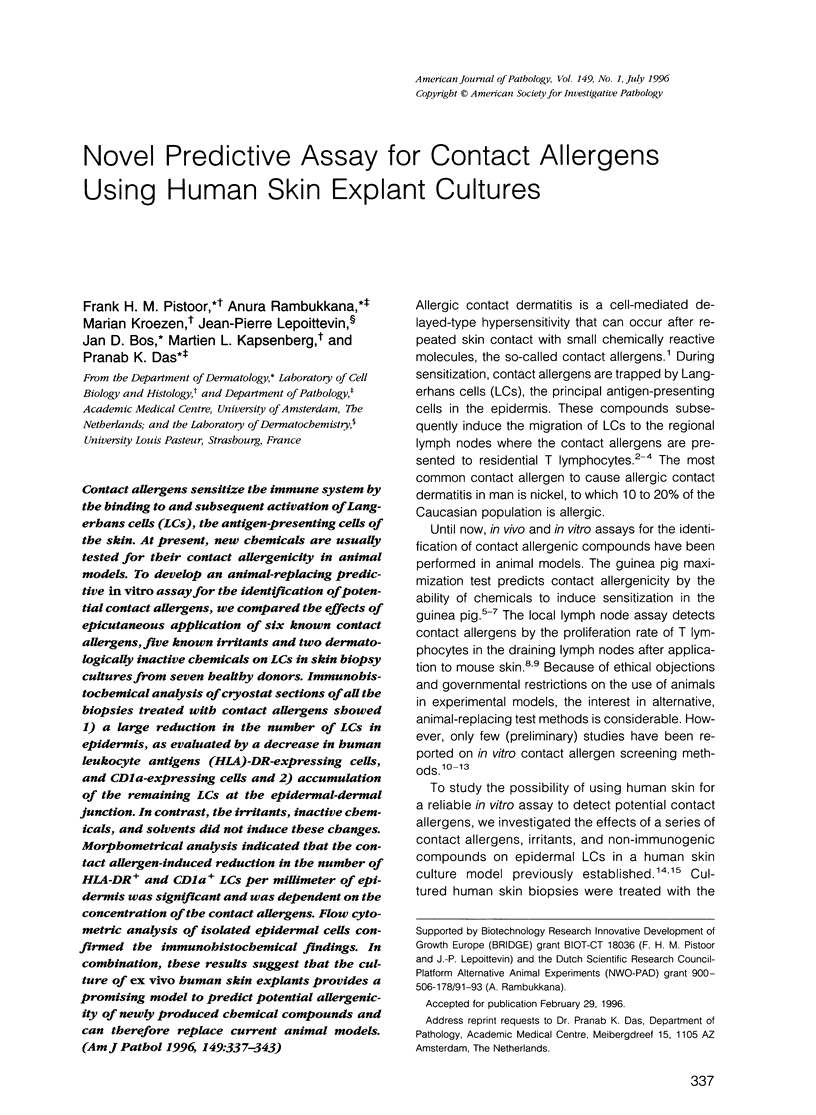
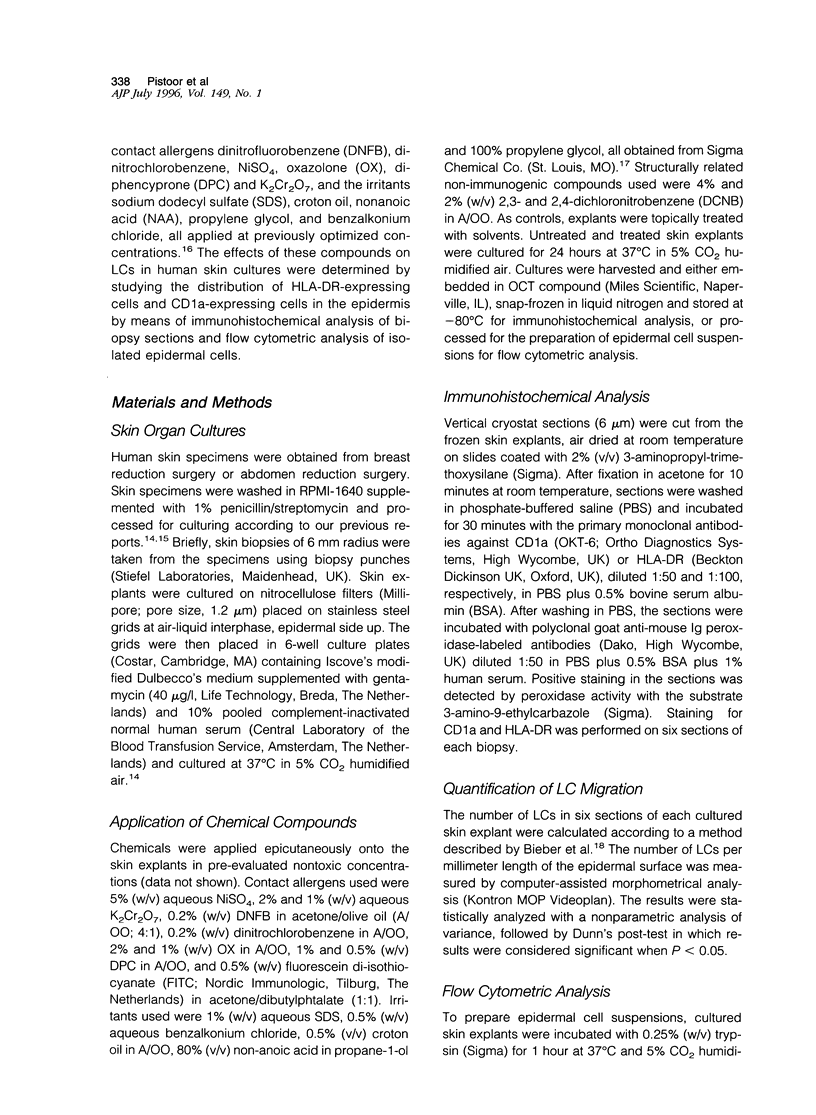
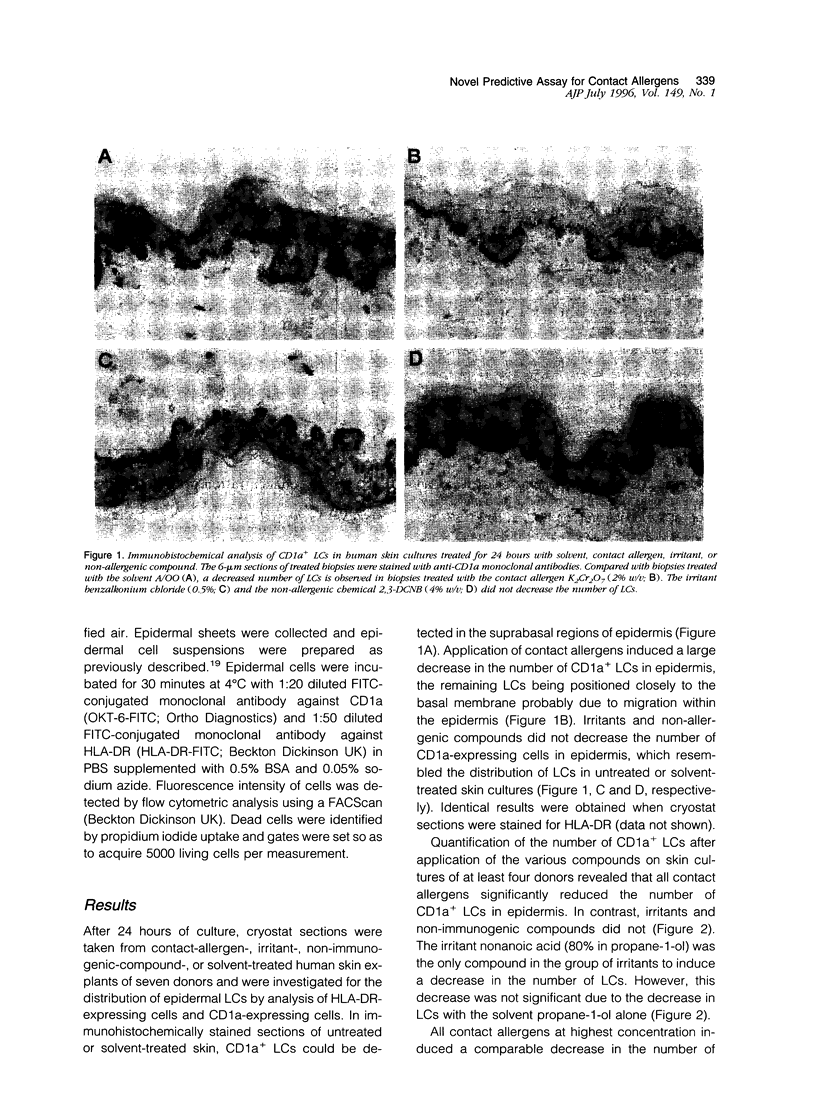
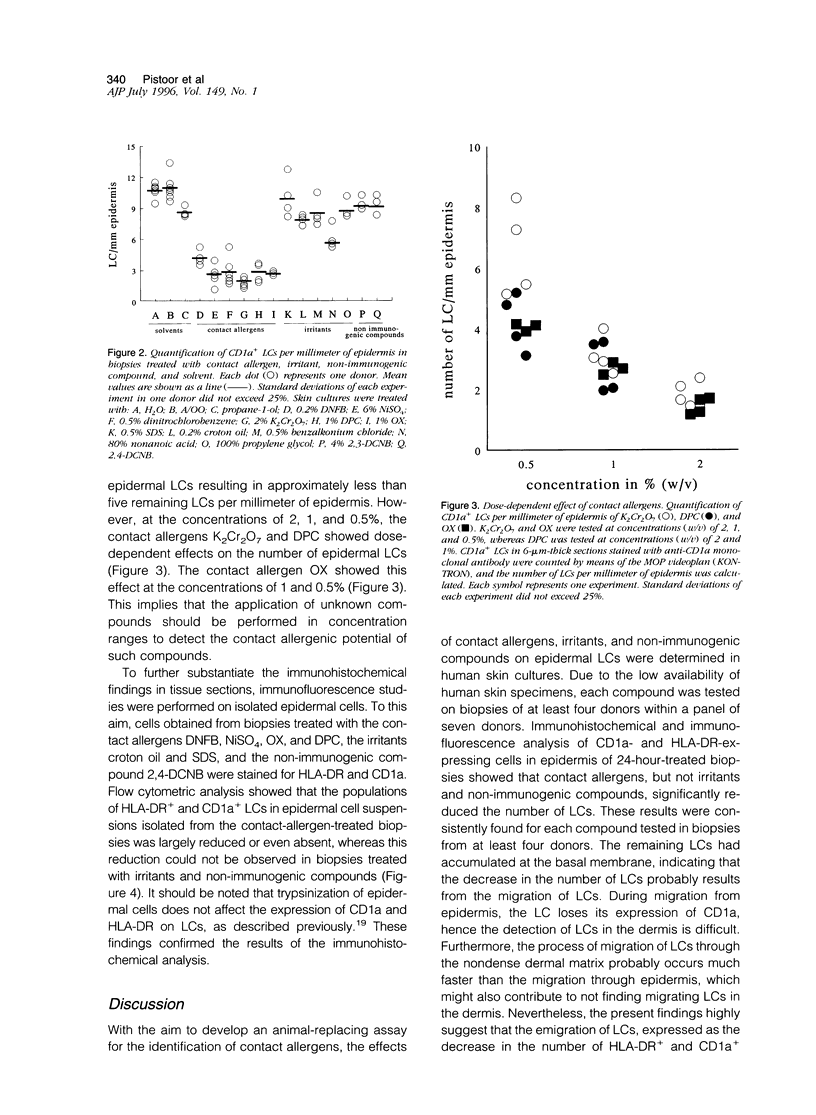
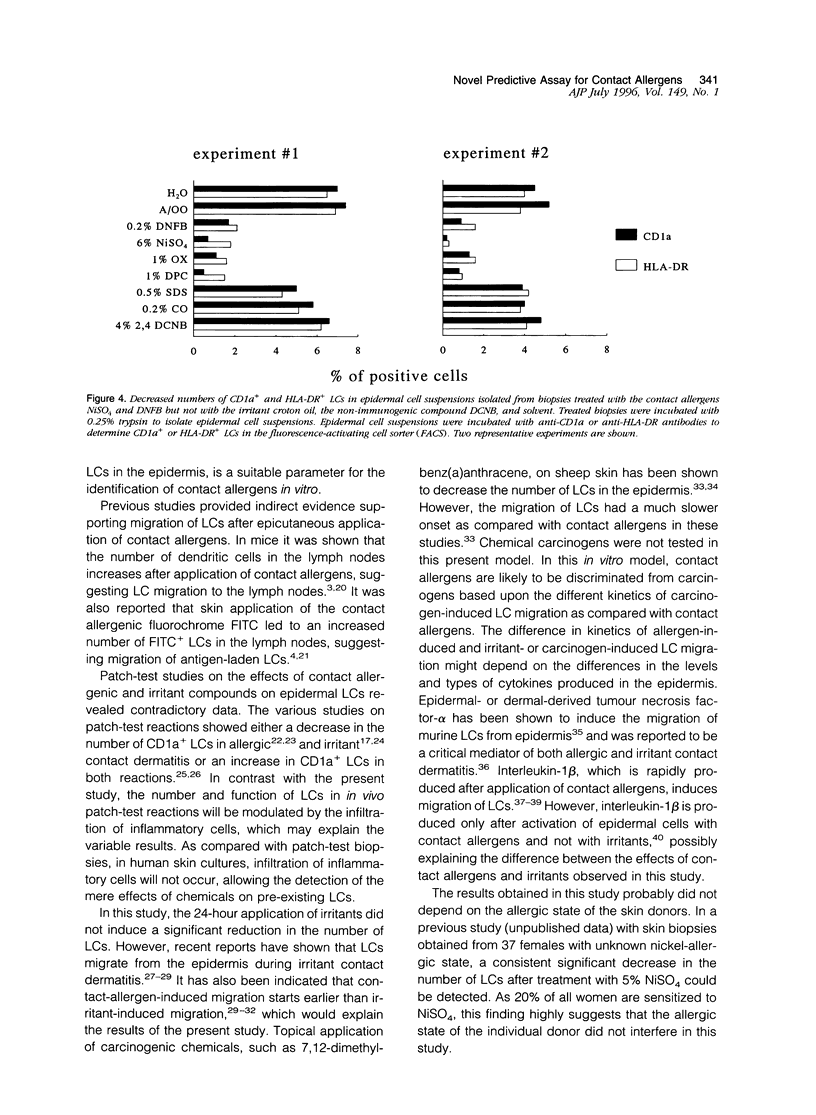
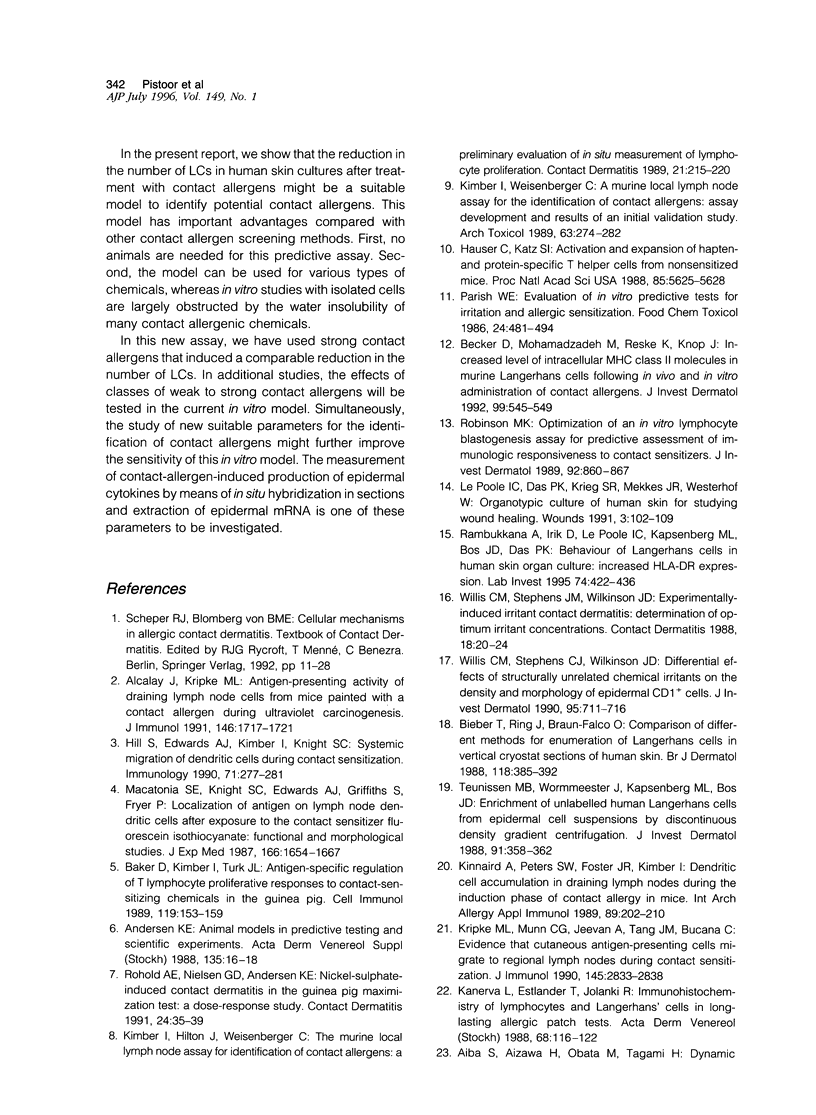
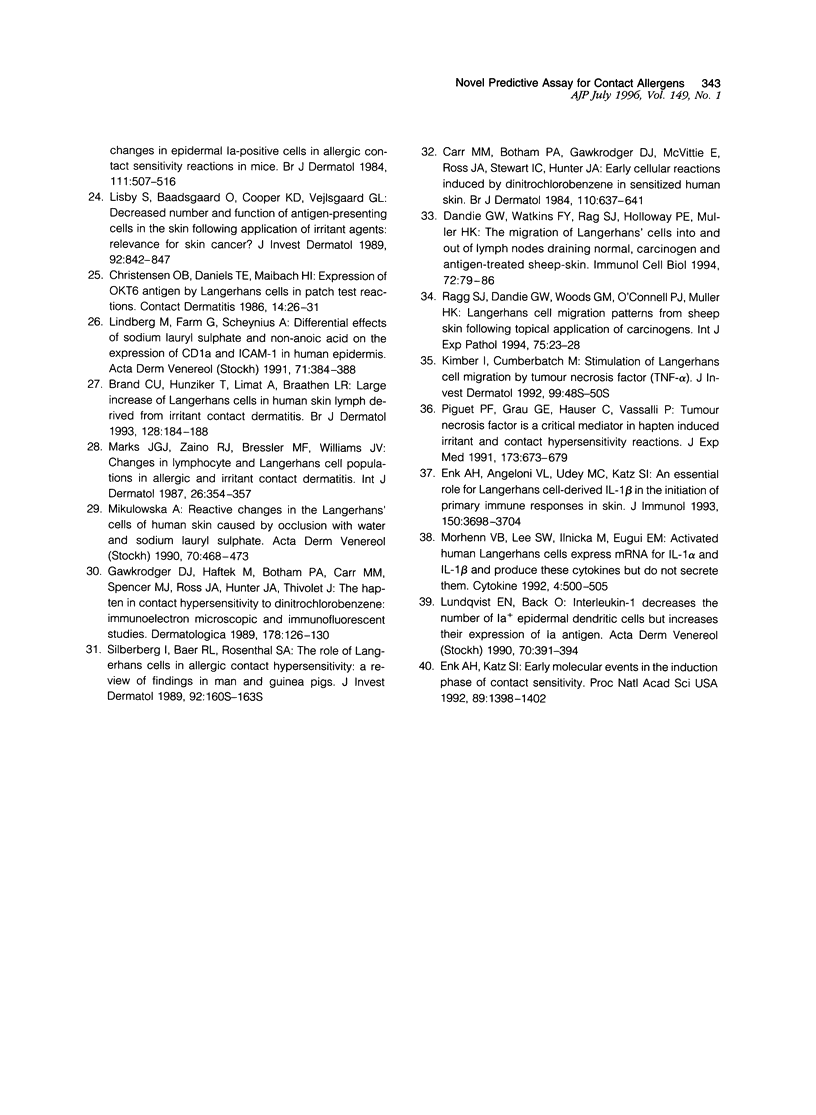
Images in this article
Selected References
These references are in PubMed. This may not be the complete list of references from this article.
- Alcalay J., Kripke M. L. Antigen-presenting activity of draining lymph node cells from mice painted with a contact allergen during ultraviolet carcinogenesis. J Immunol. 1991 Mar 15;146(6):1717–1721. [PubMed] [Google Scholar]
- Andersen K. E. Animal models in predictive testing and scientific experiments. Acta Derm Venereol Suppl (Stockh) 1988;135:16–18. [PubMed] [Google Scholar]
- Baker D., Kimber I., Turk J. L. Antigen-specific regulation of T lymphocyte proliferative responses to contact-sensitizing chemicals in the guinea pig. Cell Immunol. 1989 Mar;119(1):153–159. doi: 10.1016/0008-8749(89)90231-1. [DOI] [PubMed] [Google Scholar]
- Becker D., Mohamadzadeh M., Reske K., Knop J. Increased level of intracellular MHC class II molecules in murine Langerhans cells following in vivo and in vitro administration of contact allergens. J Invest Dermatol. 1992 Nov;99(5):545–549. doi: 10.1111/1523-1747.ep12667308. [DOI] [PubMed] [Google Scholar]
- Bieber T., Ring J., Braun-Falco O. Comparison of different methods for enumeration of Langerhans cells in vertical cryosections of human skin. Br J Dermatol. 1988 Mar;118(3):385–392. doi: 10.1111/j.1365-2133.1988.tb02432.x. [DOI] [PubMed] [Google Scholar]
- Brand C. U., Hunziker T., Limat A., Braathen L. R. Large increase of Langerhans cells in human skin lymph derived from irritant contact dermatitis. Br J Dermatol. 1993 Feb;128(2):184–188. doi: 10.1111/j.1365-2133.1993.tb15149.x. [DOI] [PubMed] [Google Scholar]
- Carr M. M., Botham P. A., Gawkrodger D. J., McVittie E., Ross J. A., Stewart I. C., Hunter J. A. Early cellular reactions induced by dinitrochlorobenzene in sensitized human skin. Br J Dermatol. 1984 Jun;110(6):637–641. doi: 10.1111/j.1365-2133.1984.tb04697.x. [DOI] [PubMed] [Google Scholar]
- Christensen O. B., Daniels T. E., Maibach H. I. Expression of OKT6 antigen by Langerhans cells in patch test reactions. Contact Dermatitis. 1986 Jan;14(1):26–31. doi: 10.1111/j.1600-0536.1986.tb01148.x. [DOI] [PubMed] [Google Scholar]
- Dandie G. W., Watkins F. Y., Ragg S. J., Holloway P. E., Muller H. K. The migration of Langerhans' cells into and out of lymph nodes draining normal, carcinogen and antigen-treated sheep skin. Immunol Cell Biol. 1994 Feb;72(1):79–86. doi: 10.1038/icb.1994.12. [DOI] [PubMed] [Google Scholar]
- Enk A. H., Angeloni V. L., Udey M. C., Katz S. I. An essential role for Langerhans cell-derived IL-1 beta in the initiation of primary immune responses in skin. J Immunol. 1993 May 1;150(9):3698–3704. [PubMed] [Google Scholar]
- Enk A. H., Katz S. I. Early molecular events in the induction phase of contact sensitivity. Proc Natl Acad Sci U S A. 1992 Feb 15;89(4):1398–1402. doi: 10.1073/pnas.89.4.1398. [DOI] [PMC free article] [PubMed] [Google Scholar]
- Gawkrodger D. J., Haftek M., Botham P. A., Carr M. M., Spencer M. J., Ross J. A., Hunter J. A., Thivolet J. The hapten in contact hypersensitivity to dinitrochlorobenzene: immunoelectron microscopic and immunofluorescent studies. Dermatologica. 1989;178(3):126–130. doi: 10.1159/000248409. [DOI] [PubMed] [Google Scholar]
- Hauser C., Katz S. I. Activation and expansion of hapten- and protein-specific T helper cells from nonsensitized mice. Proc Natl Acad Sci U S A. 1988 Aug;85(15):5625–5628. doi: 10.1073/pnas.85.15.5625. [DOI] [PMC free article] [PubMed] [Google Scholar]
- Hill S., Edwards A. J., Kimber I., Knight S. C. Systemic migration of dendritic cells during contact sensitization. Immunology. 1990 Oct;71(2):277–281. [PMC free article] [PubMed] [Google Scholar]
- Kanerva L., Estlander T., Jolanki R. Immunohistochemistry of lymphocytes and Langerhans' cells in long-lasting allergic patch tests. Acta Derm Venereol. 1988;68(2):116–122. [PubMed] [Google Scholar]
- Kimber I., Cumberbatch M. Stimulation of Langerhans cell migration by tumor necrosis factor alpha (TNF-alpha). J Invest Dermatol. 1992 Nov;99(5):48S–50S. doi: 10.1111/1523-1747.ep12668986. [DOI] [PubMed] [Google Scholar]
- Kimber I., Hilton J., Weisenberger C. The murine local lymph node assay for identification of contact allergens: a preliminary evaluation of in situ measurement of lymphocyte proliferation. Contact Dermatitis. 1989 Oct;21(4):215–220. doi: 10.1111/j.1600-0536.1989.tb03198.x. [DOI] [PubMed] [Google Scholar]
- Kimber I., Weisenberger C. A murine local lymph node assay for the identification of contact allergens. Assay development and results of an initial validation study. Arch Toxicol. 1989;63(4):274–282. doi: 10.1007/BF00278640. [DOI] [PubMed] [Google Scholar]
- Kinnaird A., Peters S. W., Foster J. R., Kimber I. Dendritic cell accumulation in draining lymph nodes during the induction phase of contact allergy in mice. Int Arch Allergy Appl Immunol. 1989;89(2-3):202–210. doi: 10.1159/000234947. [DOI] [PubMed] [Google Scholar]
- Kripke M. L., Munn C. G., Jeevan A., Tang J. M., Bucana C. Evidence that cutaneous antigen-presenting cells migrate to regional lymph nodes during contact sensitization. J Immunol. 1990 Nov 1;145(9):2833–2838. [PubMed] [Google Scholar]
- Lindberg M., Färm G., Scheynius A. Differential effects of sodium lauryl sulphate and non-anoic acid on the expression of CD1a and ICAM-1 in human epidermis. Acta Derm Venereol. 1991;71(5):384–388. [PubMed] [Google Scholar]
- Lisby S., Baadsgaard O., Cooper K. D., Vejlsgaard G. L. Decreased number and function of antigen-presenting cells in the skin following application of irritant agents: relevance for skin cancer? J Invest Dermatol. 1989 Jun;92(6):842–847. doi: 10.1111/1523-1747.ep12696867. [DOI] [PubMed] [Google Scholar]
- Lundqvist E. N., Bäck O. Interleukin-1 decreases the number of Ia+ epidermal dendritic cells but increases their expression of Ia antigen. Acta Derm Venereol. 1990;70(5):391–394. [PubMed] [Google Scholar]
- Macatonia S. E., Knight S. C., Edwards A. J., Griffiths S., Fryer P. Localization of antigen on lymph node dendritic cells after exposure to the contact sensitizer fluorescein isothiocyanate. Functional and morphological studies. J Exp Med. 1987 Dec 1;166(6):1654–1667. doi: 10.1084/jem.166.6.1654. [DOI] [PMC free article] [PubMed] [Google Scholar]
- Marks J. G., Jr, Zaino R. J., Bressler M. F., Williams J. V. Changes in lymphocyte and Langerhans cell populations in allergic and irritant contact dermatitis. Int J Dermatol. 1987 Jul-Aug;26(6):354–357. doi: 10.1111/j.1365-4362.1987.tb00558.x. [DOI] [PubMed] [Google Scholar]
- Mikulowska A. Reactive changes in the Langerhans' cells of human skin caused by occlusion with water and sodium lauryl sulphate. Acta Derm Venereol. 1990;70(6):468–473. [PubMed] [Google Scholar]
- Morhenn V. B., Lee S. W., Ilnicka M., Eugui E. M. Activated human Langerhans cells express mRNA for IL-1 alpha and IL-1 beta and produce these cytokines but do not secrete them. Cytokine. 1992 Nov;4(6):500–505. doi: 10.1016/1043-4666(92)90011-f. [DOI] [PubMed] [Google Scholar]
- Parish W. E. Evaluation of in vitro predictive tests for irritation and allergic sensitization. Food Chem Toxicol. 1986 Jun-Jul;24(6-7):481–494. doi: 10.1016/0278-6915(86)90098-0. [DOI] [PubMed] [Google Scholar]
- Piguet P. F., Grau G. E., Hauser C., Vassalli P. Tumor necrosis factor is a critical mediator in hapten induced irritant and contact hypersensitivity reactions. J Exp Med. 1991 Mar 1;173(3):673–679. doi: 10.1084/jem.173.3.673. [DOI] [PMC free article] [PubMed] [Google Scholar]
- Ragg S. J., Dandie G. W., Woods G. M., O'Connell P. J., Muller H. K. Langerhans cell migration patterns from sheep skin following topical application of carcinogens. Int J Exp Pathol. 1994 Feb;75(1):23–28. [PMC free article] [PubMed] [Google Scholar]
- Rambukkana A., Pistoor F. H., Bos J. D., Kapsenberg M. L., Das P. K. Effects of contact allergens on human Langerhans cells in skin organ culture: migration, modulation of cell surface molecules, and early expression of interleukin-1 beta protein. Lab Invest. 1996 Feb;74(2):422–436. [PubMed] [Google Scholar]
- Robinson M. K. Optimization of an in vitro lymphocyte blastogenesis assay for predictive assessment of immunologic responsiveness to contact sensitizers. J Invest Dermatol. 1989 Jun;92(6):860–867. doi: 10.1111/1523-1747.ep12696880. [DOI] [PubMed] [Google Scholar]
- Rohold A. E., Nielsen G. D., Andersen K. E. Nickel-sulphate-induced contact dermatitis in the guinea pig maximization test: a dose-response study. Contact Dermatitis. 1991 Jan;24(1):35–39. doi: 10.1111/j.1600-0536.1991.tb01627.x. [DOI] [PubMed] [Google Scholar]
- Silberberg I., Baer R. L., Rosenthal S. A. The role of Langerhans cells in allergic contact hypersensitivity. A review of findings in man and guinea pigs. 1976. J Invest Dermatol. 1989 Apr;92(4 Suppl):160S–163S. doi: 10.1038/jid.1989.50. [DOI] [PubMed] [Google Scholar]
- Teunissen M. B., Wormmeester J., Kapsenberg M. L., Bos J. D. Enrichment of unlabeled human Langerhans cells from epidermal cell suspensions by discontinuous density gradient centrifugation. J Invest Dermatol. 1988 Oct;91(4):358–362. doi: 10.1111/1523-1747.ep12475770. [DOI] [PubMed] [Google Scholar]
- Willis C. M., Stephens C. J., Wilkinson J. D. Differential effects of structurally unrelated chemical irritants on the density and morphology of epidermal CD1+ cells. J Invest Dermatol. 1990 Dec;95(6):711–716. doi: 10.1111/1523-1747.ep12514510. [DOI] [PubMed] [Google Scholar]
- Willis C. M., Stephens J. M., Wilkinson J. D. Experimentally-induced irritant contact dermatitis. Determination of optimum irritant concentrations. Contact Dermatitis. 1988 Jan;18(1):20–24. doi: 10.1111/j.1600-0536.1988.tb05484.x. [DOI] [PubMed] [Google Scholar]



